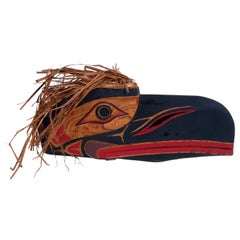Emile Thibert
Recent Sales
1990s Canadian Native American Masks
Wood
A Close Look at Native-american Furniture
Native American broadly describes any Indigenous people in North America and encompasses hundreds of tribes and groups, all with distinct cultures. Native American–style furniture and decor likewise varies widely, from pieces created by Indigenous people to those appropriated by non-native designers.
Indigenous furniture’s rich heritage includes the bentwood boxes of the Northwest Coast carved from cedar for storing household or ceremonial objects. Generations of Native American people have made baskets for holding household items, with those in the Northeast using sweetgrass and those in the Southeast using pine needles and wicker. Artisans in the Plateau region wove watertight pieces like cradles from plant materials. Although these objects were intricately made, they were usually utilitarian rather than decorative.
The colonization of North America and the removal of Indigenous people from their lands led to the suppression of these practices. Many styles that used Native American motifs — such as Southwestern style, which was heavily influenced by the geometric patterns of Navajo textiles — have historically not involved Indigenous creators and, instead, have taken their traditions without their tribal context.
When decorating a home with Native American–style furniture, it is important to do so respectfully, by understanding the origins of motifs and objects and examining who profits from their sale. There are now Indigenous-led companies, such as Cherokee designer Cray Bauxmont-Flynn’s Amatoya and Totem House Design, promoting Indigenous work in furniture and home decor. Supporting Indigenous artists and artisans is essential to confronting the still pervasive issue of cultural appropriation in design.
Find a collection of Native American living room furniture, folk art, rugs and carpets, decorative objects and other items on 1stDibs.
Finding the Right Masks for You
Today, art enthusiasts and venturesome interior designers find a lot to love and appreciate about antique and vintage masks, particularly as they have earned a distinct place amid a collection of folk art and other collectibles and curiosities in contemporary homes.
Folk art refers to art that people, not classically trained, created for either utilitarian or decorative purposes. With respect to visual art in folk art, it is typically reflective of a community’s culture and usually handmade by craftspeople working within a popular tradition. Masks, as part of this history, have been used in carnivals, theater, medicine, therapy, religion and more. The use of masks in rituals and sacred ceremonies goes back thousands of years, and masks in general are believed to be much older. And all kinds of other uses have been found for masks and face coverings over time. We have enlisted these accessories for protection, to signal modesty, facilitate flirtation, enable licentiousness or simply to look cool.
Archaeologists found a mask in Palestine that is believed to be 9,000 years old, a Neolithic-era stone mask that may have been part of rituals associated with the worship of ancestors. Some tribal masks are worn as an offering to the gods. Masks are among the most important African art forms, for example, and traditional African masks can be used to lend a concrete form to an invisible spirit. Dancers donning wooden tribal masks celebrate important events to honor their deceased ancestors. These masks are also very important devices for storytelling and sharing the oral history of a community.
For Asian artists, specific colors are used in masks to convey different values and ideas. In Japan, a red Oni mask worn by performers during a festival might signify anger, while in China’s Peking Opera, a mask that has been hand-painted gold would be worn by an immortal.
Mexican craftspeople make masks for traditional celebrations and ceremonial dances. Mexican masks are part of the country’s folk-art traditions that go back thousands of years and play a role in festivals and theater. A common symbol of the Mexican holiday Day of the Dead is a skull, which is widely represented in masks (although the innumerable activities associated with the holiday are by no means universal).
We’re inviting you to explore and pay respect to the long folk-art traditions that underpin mask-making by introducing antique and vintage masks to your space. Find an exciting collection on 1stDibs today.
